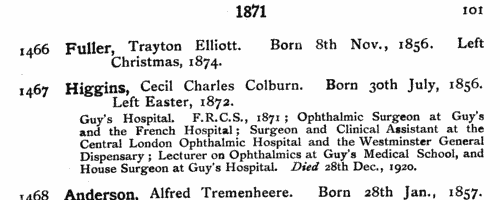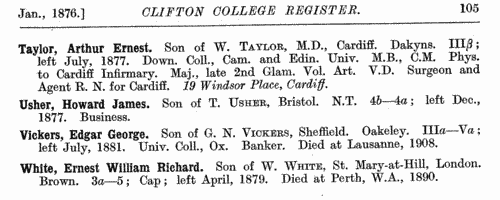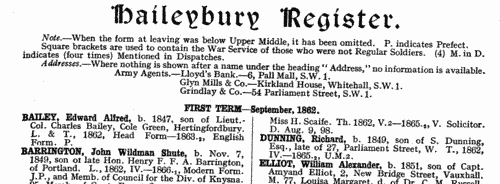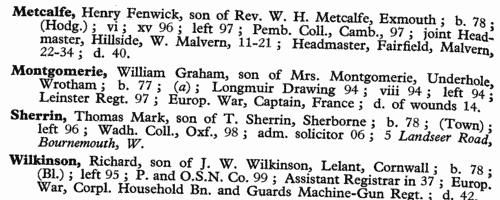Add this eBook to your basket to receive access to all 1,845 records. Our indexes include entries for the spelling nelson. In the period you have requested, we have the following 1,845 records (displaying 1,361 to 1,370): These sample scans are from the original record. You will get scans of the full pages or articles where the surname you searched for has been found. Your web browser may prevent the sample windows from opening; in this case please change your browser settings to allow pop-up windows from this site. Bankrupts, Assignees, Trustees and Solicitors
(1882)
Bankruptcy notices in England and Wales. | Sample scan, click to enlarge

| Boys entering Brighton College
(1882)
This edition of the Brighton College Register was published in 1922. The plan of the publication was to list boys by year or, later, term of entry. Each name is assigned a sequential number, 5000 boys, in all, being recorded. Full name is given (surname first, in bold); year of birth; year of leaving; and then (wherever the compiler had such information) a short biography, ending with date of death, where known. | Sample scan, click to enlarge

| Boys entering Clifton College
(1882)
Clifton College near Bristol was established in 1862. This edition of the Clifton College Annals and Register for the Old Cliftonian Society by F. Borwick was published in 1925. Boys are listed alphabetically by term of entry, with full names, surname first, in bold. Father's (or widowed mother's) name is given (surname and initials) in capitals, and address. Then there is the name of the house (N. T., North Town; S. H., School House; S. T., South Town), first and last forms, distinctions in school work and games, and month of leaving. Where known, the editor then gave a career summary with month of death; or, if still living, address as in 1925 (in italics). | Sample scan, click to enlarge

| Boys entering Haileybury College, Hertfordshire
(1882)
Haileybury College, near Hertford, was founded by the East India Company in 1806, and incorporated by Royal Charter in 1864. This register of pupils entering the school from 1862 to 1931 was edited by a master there, Laurence Arthur Speakman. The boys are listed by term of joining the school, and then alphabetically by name (in bold), surname first (in capitals). There is then usually a precise birthdate, and the name and address of his father; his period at the school, starting with abbreviations to indicate the house to which he belonged (B., Batten; B. F., Bartle Frere; C., Colvin; E., Edmonstone; Ha., Hailey; Hi., Highfield; L., Lawrence; Le B., Le Bas; M., Melvill; Th., Thomason; T., Trevelyan), and the first and last forms attended (e. g., IV., fourth form). Where a member of a school team there is then an indication (e. g., XI., cricket). For some pupils, with whom the school had lost touch, Speakman was only able to record the details of their time at Haileybury; but for most a brief career synopsis is then given, and current address (as in 1931) or date of death.
| Sample scan, click to enlarge

| Boys entering Sherborne School
(1882)
The grammar school at Sherborne in Dorset, which doubtless existed from the creation of the diocese of Sherborne in 705, was refounded by king Edward VI in 1550. At the quatercentenary in 1950, a fourth edition of the Sherborne Register was published, listing boys entering the school during those four centuries. In truth, the materials for this register survive but fitfully before 1823; for some years, no names are known; sometimes all that is known is a surname. But from 1823 onwards the lists and the details get steadily more comprehensive. By the 20th century the boys are listed alphabetically by surname under term of entrance. Surname is given in bold, then christian names, name of father (surname and initials) and address; year of birth; house (a, School House; b, Abbey House; c, The Green; d, Harper House (formerly The Retreat); f, Abbeylands; g, Lyon House; h, Westcott House); whether represented the school at cricket (xi), football (xv), shooting (viii), &c.; year of leaving; summary of degrees, career &c.; and (in italics), address as of 1950. Names in the early lists marked with an asterisk are found inscribed on the oak panelling or on the stone walls of the former schoolroom. (F) in the lists indicates a foundationer, receiving free education: after 1827, when this privilege was restricted to boys from Sherborne and neighbourhood, nearly all foundationers were day-boys. | Sample scan, click to enlarge

|  British army engineers fighting in Egypt
(1882) British army engineers fighting in Egypt
(1882)
The war medal roll for the Egyptian campaign of 1882 is annotated to show those men actually present at Tel-el-Kebir, and thereby also entitled to the Tel-el-Kebir clasp. In addition, there follows an almost duplicate roll of men entitled to the Bronze Star granted by the Khedive of Egypt in recognition of the campaign. Several companies of the Royal Engineers supported the troops. | Sample scan, click to enlarge

| City of Oxford Electors
(1882)
The electoral register for the City of Oxford for 1882 lists persons entitled to vote at any election of a member or members to serve in parliament for the city or parliamentary borough of Oxford in that year. The names are arranged alphabetically in the parishes of Saint Aldate, Binsey, Saint Clement, Cowley, Saint Ebbe, Saint Giles, Headington, Holywell, Iffley, Saint John, Saint Martin, Saint Mary Magdalen, Saint Mary the Virgin, Saint Michael, North Hincksey and South Hincksey (in Berkshire), Saint Peter in the East, Saint Peter le Bailey, and Saint Thomas. In each case the voter number (out of a total of 6190) is given in the first column; then full name, surname first; place of abode; nature of qualification (such as house, &c.); and the name and situation of the qualifying property (often the same as the place of abode). At the end of each parish there is a list of freemen to be registered as parliamentary voters, with number, full name (surname first) and place of abode; and a list of lodgers registered as parliamentary voters, with number, full name (surname first), description of rooms occupied, and whether furnished or not, address, amount of rent paid, and name and address of landlord. | Sample scan, click to enlarge

|  Coldstream Guards fighting in Egypt
(1882) Coldstream Guards fighting in Egypt
(1882)
The war medal roll for the Egyptian campaign of 1882 is annotated to show those men actually present at Tel-el-Kebir, and thereby also entitled to the Tel-el-Kebir clasp. In addition, there follows an almost duplicate roll of men entitled to the Bronze Star granted by the Khedive of Egypt in recognition of the campaign. The 2nd battalion, the Coldstream Guards, fought in the 1882 campaign, taking part in the battle of Tel-el-Kebir: this medal roll was compiled in Cairo in October 1882, shortly before the battalion returned to England. | Sample scan, click to enlarge

| Debtors
(1882)
County Court Judgments in England and Wales | Sample scan, click to enlarge

| Debtors, Insolvents and Bankrupts
(1882)
Bills of sale (binding assets to a creditor/lender), insolvencies and bankruptcies in England and Wales, April to June 1882 | Sample scan, click to enlarge

|
Research your ancestry, family history, genealogy and one-name study by direct access to original records and archives indexed by surname.
|












